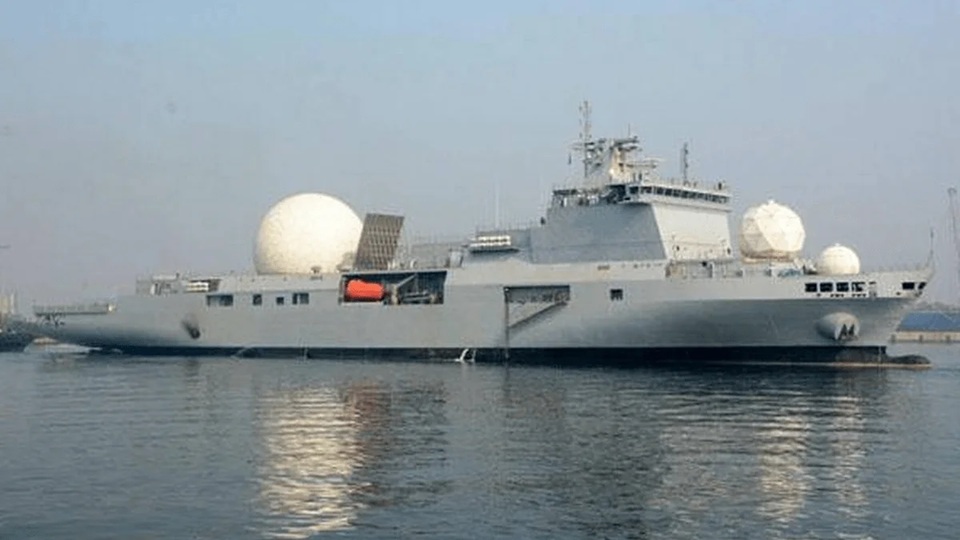India has significantly strengthened its maritime and strategic surveillance infrastructure with the deployment of INS Dhruv, a sophisticated missile tracking and telemetry ship now operational under the Indian Navy. Officially inducted in 2021, this high-tech vessel symbolizes India’s growing focus on enhancing its defense posture in the Indo-Pacific and reinforcing its nuclear command and control architecture.
INS Dhruv represents a major technological leap in India's maritime surveillance efforts. Built by Hindustan Shipyard Limited in collaboration with the Defense Research and Development Organization (DRDO) and the National Technical Research Organisation (NTRO), the vessel is designed to monitor long-range missile launches, space assets, and electronic signatures across vast distances. Its deployment adds considerable weight to India's ability to track and respond to potential threats from across the region.
Inside the Vessel: Surveillance at Sea
INS Dhruv is no ordinary ship—it’s a specialized missile range instrumentation platform, equipped with advanced radar systems capable of detecting and tracking ballistic and cruise missiles. The vessel carries multiple radar domes housing both X-band and S-band radars, enabling it to track missile trajectories, satellite movements, and high-altitude aerial targets in real time.
With a displacement exceeding 10,000 tonnes, Dhruv is one of the largest surveillance ships operated by the Indian Navy. The ship also serves as a mobile data collection center, capable of supporting missile test telemetry and relaying information critical for validating India's strategic weapons systems, such as the Agni-series and K-series nuclear-capable missiles.
The onboard systems are believed to be capable of detecting missile launches from a range exceeding 1,000 kilometers, and the ship plays a crucial role during live missile trials. It assists in collecting precise telemetry and trajectory data, crucial for weapon system refinement and validation.
Strengthening Strategic Deterrence
The strategic significance of INS Dhruv cannot be overstated. It plays a vital role in supporting India's nuclear triad, which includes the ability to launch nuclear weapons from land-based systems, aircraft, and submarines. In particular, the vessel aids the Strategic Forces Command (SFC) in improving situational awareness and ensuring command and control stability over India’s nuclear arsenal.
By enabling long-range tracking of missile launches—both domestic and foreign—INS Dhruv enhances India’s second-strike capability, a cornerstone of its stated No First Use (NFU) nuclear doctrine. This sea-based surveillance allows Indian defense planners to closely observe the strategic behavior of adversaries, particularly in an era where both Pakistan and China are actively advancing their missile programs.
A Joint Effort: Navy, DRDO, NTRO
The vessel’s development and operations represent coordinated synergy between various arms of the Indian defense establishment. While the DRDO was responsible for integrating high-frequency radar and telemetry systems, the NTRO provided the electronic intelligence suite necessary for long-distance monitoring. The Indian Navy, tasked with operating the ship, ensures the vessel is integrated within larger maritime command protocols.
The design of INS Dhruv allows it to be deployed flexibly—along India's eastern or western coasts—depending on the strategic requirement. The ship is also likely to play a role in supporting space situational awareness, offering additional utility in the evolving defense-space intersection.
Global Context and Strategic Implications
The arrival of INS Dhruv has not gone unnoticed in strategic circles around the world. With China expanding its maritime influence and missile arsenal, and Pakistan conducting frequent missile drills, India’s development of such a platform is seen as both defensive and stabilizing in nature.
Experts view INS Dhruv as part of a broader modernization drive within the Indian armed forces, which includes investments in satellite-based communication, hypersonic missile development, and missile defense architecture. Notably, India remains one of the few nations globally to operate a dedicated sea-based missile tracking vessel, placing it in a strategic league with countries like the United States, Russia, and China.
Moreover, the platform enhances India’s role as a key stakeholder in ensuring peace and stability in the Indian Ocean Region (IOR). It strengthens maritime domain awareness and enables India to contribute more robustly to international cooperative missions, including missile non-proliferation and maritime threat detection.
The Road Ahead
INS Dhruv is expected to be the first of potentially multiple such platforms as India builds out its space-based and sea-based early warning systems. Future upgrades may include enhanced satellite communication relays, integration with India's ballistic missile defense shield, and support for anti-satellite (ASAT) capability assessments.
Given its current capabilities, Dhruv is likely to be deployed during future ballistic missile tests, space launches, and periods of heightened security along India's strategic frontiers. Its presence serves as a message to allies and adversaries alike: India is not only building a credible defense architecture but also shaping itself into a high-technology security provider in the Indo-Pacific.
Conclusion
INS Dhruv symbolizes India's entry into a new era of sea-based strategic surveillance. Beyond the impressive radar systems and missile tracking functions, the ship reflects the country’s broader ambition—to secure its interests, deter potential threats, and reinforce its position as a responsible nuclear power. As geopolitical competition intensifies, platforms like INS Dhruv will form the backbone of India’s maritime and strategic security framework for years to come.
